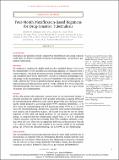Files in this item
Four-month moxifloxacin-based regimens for drug-sensitive tuberculosis
Item metadata
| dc.contributor.author | Gillespie, Stephen H. | |
| dc.contributor.author | Crook, Angela M. | |
| dc.contributor.author | McHugh, Timothy D. | |
| dc.contributor.author | Mendel, Carl M. | |
| dc.contributor.author | Meredith, Sarah K. | |
| dc.contributor.author | Murray, Stephen R. | |
| dc.contributor.author | Pappas, Frances | |
| dc.contributor.author | Phillips, Patrick P.J. | |
| dc.contributor.author | Nunn, Andrew J. | |
| dc.contributor.author | for the REMoxTB Consortium | |
| dc.date.accessioned | 2015-03-07T00:01:34Z | |
| dc.date.available | 2015-03-07T00:01:34Z | |
| dc.date.issued | 2014-10-23 | |
| dc.identifier | 147208418 | |
| dc.identifier | 96f1f5d7-f986-4949-8aa2-ce814da4e30c | |
| dc.identifier | 25196020 | |
| dc.identifier | 84908126151 | |
| dc.identifier | 000343648500006 | |
| dc.identifier.citation | Gillespie , S H , Crook , A M , McHugh , T D , Mendel , C M , Meredith , S K , Murray , S R , Pappas , F , Phillips , P P J , Nunn , A J & for the REMoxTB Consortium 2014 , ' Four-month moxifloxacin-based regimens for drug-sensitive tuberculosis ' , New England Journal of Medicine , vol. 371 , no. 17 , pp. 1577-1587 . https://doi.org/10.1056/NEJMoa1407426 | en |
| dc.identifier.issn | 0028-4793 | |
| dc.identifier.other | Bibtex: urn:1185a7a37968db08f4c89afb08fb9184 | |
| dc.identifier.other | ORCID: /0000-0001-6537-7712/work/39477830 | |
| dc.identifier.uri | https://hdl.handle.net/10023/6192 | |
| dc.description | Supported by the Global Alliance for TB Drug Development with support from the Bill and Melinda Gates Foundation, the European and Developing Countries Clinical Trials Partnership, U.S. Agency for International Development, U.K. Department for International Development, Directorate General for International Cooperation of the Netherlands, Irish Aid, Australia Department of Foreign Affairs and Trade, and National Institutes of Health, AIDS Clinical Trials Group and by grants from the National Institute of Allergy and Infectious Diseases (NIAID) (UM1AI068634, UM1 AI068636, and UM1AI106701) and by NIAID grants to the University of KwaZulu Natal, South Africa, AIDS Clinical Trials Group (ACTG) site 31422 (1U01AI069469); to the Perinatal HIV Research Unit, Chris Hani Baragwanath Hospital, South Africa, ACTG site 12301 (1U01AI069453); and to the Durban International Clinical Trials Unit, South Africa, ACTG site 11201 (1U01AI069426); Bayer Healthcare for the donation of moxifloxacin; and Sanofi for the donation of rifampin. | en |
| dc.description.abstract | Background: Early-phase and preclinical studies suggest that moxifloxacin-containing regimens could allow for effective 4-month treatment of uncomplicated, smear-positive pulmonary tuberculosis. Methods: We conducted a randomized, double-blind, placebo-controlled, phase 3 trial to test the noninferiority of two moxifloxacin-containing regimens as compared with a control regimen. One group of patients received isoniazid, rifampin, pyrazinamide, and ethambutol for 8 weeks, followed by 18 weeks of isoniazid and rifampin (control group). In the second group, we replaced ethambutol with moxifloxacin for 17 weeks, followed by 9 weeks of placebo (isoniazid group), and in the third group, we replaced isoniazid with moxifloxacin for 17 weeks, followed by 9 weeks of placebo (ethambutol group). The primary end point was treatment failure or relapse within 18 months after randomization. Results: Of the 1931 patients who underwent randomization, in the per-protocol analysis, a favorable outcome was reported in fewer patients in the isoniazid group (85%) and the ethambutol group (80%) than in the control group (92%), for a difference favoring the control group of 6.1 percentage points (97.5% confidence interval [CI], 1.7 to 10.5) versus the isoniazid group and 11.4 percentage points (97.5% CI, 6.7 to 16.1) versus the ethambutol group. Results were consistent in the modified intention-to-treat analysis and all sensitivity analyses. The hazard ratios for the time to culture negativity in both solid and liquid mediums for the isoniazid and ethambutol groups, as compared with the control group, ranged from 1.17 to 1.25, indicating a shorter duration, with the lower bounds of the 95% confidence intervals exceeding 1.00 in all cases. There was no significant difference in the incidence of grade 3 or 4 adverse events, with events reported in 127 patients (19%) in the isoniazid group, 111 (17%) in the ethambutol group, and 123 (19%) in the control group. Conclusions: The two moxifloxacin-containing regimens produced a more rapid initial decline in bacterial load, as compared with the control group. However, noninferiority for these regimens was not shown, which indicates that shortening treatment to 4 months was not effective in this setting. (Funded by the Global Alliance for TB Drug Development and others; REMoxTB ClinicalTrials.gov number, NCT00864383.) | |
| dc.format.extent | 11 | |
| dc.format.extent | 502158 | |
| dc.language.iso | eng | |
| dc.relation.ispartof | New England Journal of Medicine | en |
| dc.subject | RA0421 Public health. Hygiene. Preventive Medicine | en |
| dc.subject | BDC | en |
| dc.subject | R2C | en |
| dc.subject | SDG 3 - Good Health and Well-being | en |
| dc.subject.lcc | RA0421 | en |
| dc.title | Four-month moxifloxacin-based regimens for drug-sensitive tuberculosis | en |
| dc.type | Journal article | en |
| dc.contributor.institution | University of St Andrews. School of Medicine | en |
| dc.contributor.institution | University of St Andrews. Global Health Implementation Group | en |
| dc.contributor.institution | University of St Andrews. Gillespie Group | en |
| dc.contributor.institution | University of St Andrews. Biomedical Sciences Research Complex | en |
| dc.contributor.institution | University of St Andrews. Infection Group | en |
| dc.identifier.doi | 10.1056/NEJMoa1407426 | |
| dc.description.status | Peer reviewed | en |
| dc.date.embargoedUntil | 2015-03-07 |
This item appears in the following Collection(s)
Items in the St Andrews Research Repository are protected by copyright, with all rights reserved, unless otherwise indicated.

